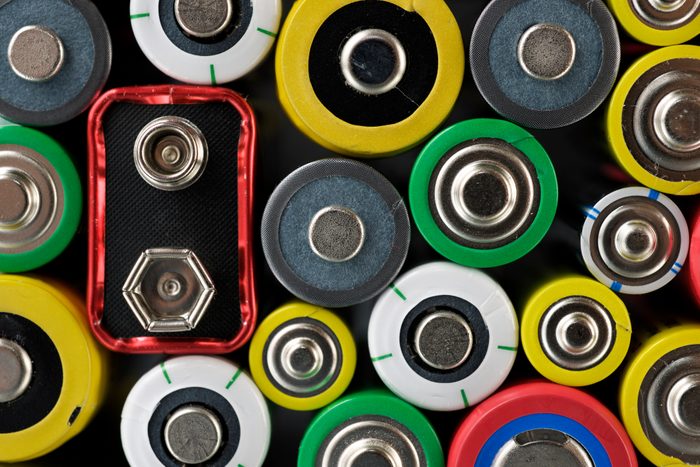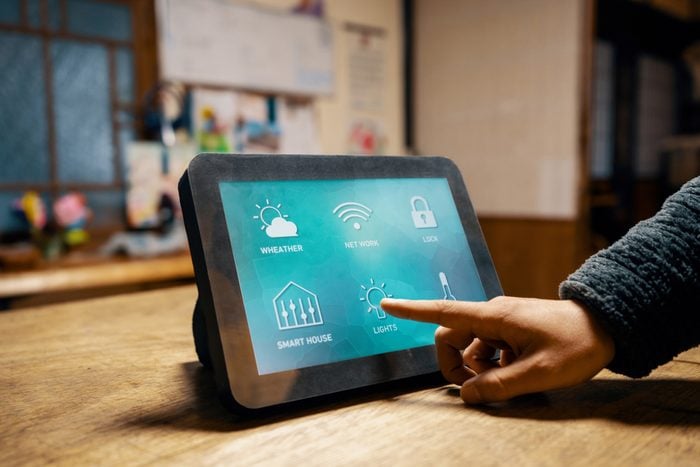
Battery Drain
Wireless smart home devices are convenient to install, but rely on battery power. If you’re constantly replacing batteries, you may have a battery drain issue.
How to fix
- Check your Wi-Fi connection: Move your devices closer to the router, or update your router. Constantly searching for an internet connection drains battery life.
- Close unused features: Running optional devices you don’t need wastes energy.
- Reduce motion detection settings: For security cameras, Rodriguez says “try to set the device settings to their minimum.” Less sensitive cameras use less energy.
- Switch to hard-wired: “Try to avoid using batteries,” Garvey says.
- Small solar panels: For outdoor devices that cannot be hard-wired, Garvey suggests installing a small solar panel to extend battery life.

Spotty Wi-Fi Connection
When a Wi-Fi signal is weak or disrupted, smart home devices may stop working or work intermittently. “A spotty Wi-Fi connection usually has to do more with the network router than the device itself,” Rodriguez says.
How to fix
- Try a new router location: Move it to a more central location in your home.
- Buy a new router: A new, high-quality router can handle the additional traffic and speed of your smart home devices.
- Buy a bigger router: “I highly recommend my clients purchase a large coverage router or a mesh routing system,” Rodriguez says. Mesh systems come with pods that can be placed throughout a home, spreading the signal better.
- Keep up with software updates: Updates refine the performance and efficiency of networking devices. Skipping updates can slow Wi-Fi speeds.

Incompatibility Across Devices
For years, smart home devices could not communicate with each other. Users were forced to control their settings from a multitude of apps, a time-consuming pain.
This changed last year with the release of Matter, a universal standard for smart devices adopted by more than 550 manufacturers. “[It] allows you to pair devices and have functionality on whichever platform you choose,” Rodriguez says.
How to fix
- Buy Matter devices: Look for the Matter logo on new smart home devices to ensure compatibility.
- Install updates: Many companies are including Matter-related updates, so users can upgrade existing devices.

Privacy Concerns
“Many people are concerned about privacy,” Rodriguez says. Rightfully so.
Smart home devices collect data about your habits and routines, which can be sold to third-party companies without your consent. They’re also vulnerable to cyber-attacks that leave personal information at risk.
“It’s definitely a concern,” Garvey says. “But there are things you can do to make your information safer.”
How to fix
- Buy name-brand devices: Industry-leading companies manufacture devices with well-tested security features. “Stay with the big players,” Garvey says.
- Set up a guest network: This prevents unauthorized access to sensitive information.
- Keep software up to date: Updates often include security improvements.
- Secure your smartphone: Use your screen lock feature and a strong password to protect information in case your phone is lost, stolen or hacked.

Difficult To Use
This is a common complaint no matter how tech-savvy you are. Instead of flipping a switch, homeowners must open an app to turn off a light. This can be a big adjustment for new users, but there are solutions.
How to fix
- Buy devices with manual controls: Some devices have traditional manual control systems as well as remote controls.
- Buy a smart switch: These can be retrofitted to app-only devices to provide a manual control method.
- Do some homework: “When a customer experiences difficult-to-use devices, I recommend that they look up more information on the device and how other people use it,” Rodriguez says. “They may end up finding a lot of beneficial information.” Sites like Reddit and YouTube are great resources. Type in the device name and a phrase like ‘for beginners’ or ‘user guide’ to get helpful topic threads or videos.

Inaccurate Activation
Motion activated devices can become a nuisance if triggered constantly. “If you’re getting pop-ups every time a squirrel runs through the backyard, that’s super annoying,” Garvey says.
How to fix
- Move your cameras: Angle them to avoid certain activation triggers.
- Adjust sensitivity settings: “You can set the device’s sensitivity settings to trigger from something the size of a car or something the size of a bird,” Garvey says. “By adjusting those settings you can [determine] when you get an actual notification.”
- Create a region of interest: Focused alert areas within the camera view, regions of interest (ROI) can also reduce false alarms. Users can create a camera’s ROI to direct it where to focus and send alerts. “[A ROI tells the camera] show me what happens in my yard, don’t show me what happens on the street,” Garvey says.
About the Experts
Robert Garvey has more than 20 years in the audio-visual world. He owns and operates Heritage Electrical and Smart Technologies in Norfolk, Massachusetts.
Miguel Rodriguez is the owner of MR Smart Home in Schenectady, New York. He has eight years of experience in the industry.

